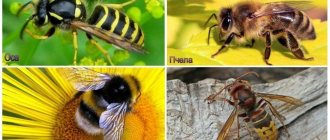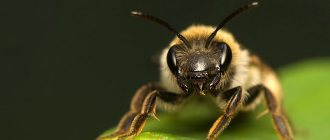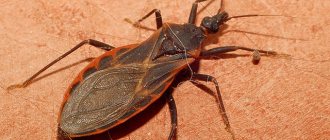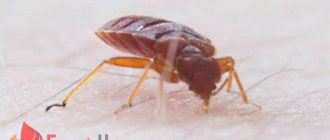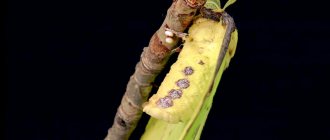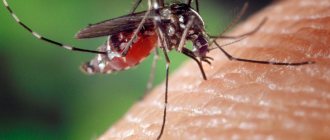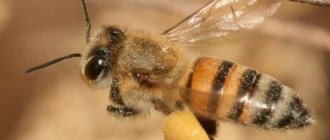Many people do not know the difference between a bee and a wasp, since the insects are very similar in size and striped body color. But this is not just the first glance. There are a lot of differences between them: habitat, physiology, lifestyle. In the summer, through open windows, striped guests often fly into apartments, houses, and car interiors. To protect yourself and others from painful stings, you first need to understand the difference between a wasp and a bee.
Types of bees and wasps: are there any that are very similar to each other?
For children and people far from science, most species of bees and wasps will seem similar. Mimicking species (flies, butterflies, beetles, etc.) can be distinguished separately. All these insects belong to the order Hymenoptera, and similarities are observed within it.
The need for imitation is determined for harmless insects by the desire to protect themselves: the colors, reminiscent of the integument of a wasp, are perceived as a message about the aggressiveness of the owner, the presence of deadly jaws and stings. The oral apparatus of wasps is capable of grinding wood into paper and allows them to obtain food of animal origin (for the most part, to kill other insects). Therefore, much greater similarity is observed in this direction (glass butterfly, hoverfly, short-winged fly).
Bees are more peaceful creatures . The activity of the family is aimed at producing honey on a larger scale than other species. This is facilitated by the restructuring of the jaw apparatus into a proboscis and fluffy fur on the integument of the body. Bees cope with predators together; they do not need to imitate wasps. Representatives of the species are at enmity with each other; a wasp can even fly into a bee hive while hunting.
Within the subfamilies of wasps, bees and bumblebees, more than 20 thousand species are distinguished. Representatives of the species are similar in their habits, lifestyle and appearance.
Color
You can identify the difference between a bee and a wasp visually by their appearance. The color of the bee is muted yellow with black stripes. The body is covered with hairs.
The wasp is distinguished by a smooth body without signs of hair, rich yellow and contrasting black stripes. The bright “robe” of the insect is noticeable from a great distance. But the wasp does not need thick hair, because collecting nectar is not its main business.
What function do they perform?
For humans, bees are a vital insect, capable of pollinating a third of the world's plant crops. Pollen transfer required:
- cucumbers;
- soy;
- kiwi;
- citrus;
- pumpkin;
- melon;
- cotton;
- coffee tree, etc.
In addition, alfalfa and clover used in livestock feeding depend on bees for their life cycle. Representatives of the family provide the production of wax, propolis and royal jelly. The British Beekeepers' Association has calculated the contribution of bees to the global economy. The work they do on the major plant species used for human food alone is equivalent to €130 billion. The amount does not include the production of honey and related products.
Bees also influence the biological diversity of ecosystems. The transfer of pollen on body hairs provides genetic diversity in plants. Phytocenoses cultivated by bees are capable of self-sustaining without human intervention.
Due to the aggressive nature of wasps, their functions are limited to the destruction of pests, including mole crickets, and indirect protection of weak insects (imitation of the striped colors of harmless species).
The peptide toxin mastoparan contained in wasp venom is capable of destroying living cells and tissues. The scientific community is trying to develop an analog synthetic substance that selectively affects cancer cells.
Nests
A family of real bees, in the absence of ready-made artificial hives and bumblebees, finds a suitable cavity and begins to build honeycombs there. Their nests do not have a specific shape, as they depend on the cavity in which the queen has settled.
The most common and familiar to us, real wasps, at the sight of which people are not mistaken about the identity of the insect, build nests on their own. In Russia, there can be two types: a vertically elongated top (the kind they depict in cartoons) and a curved “plate” of irregular shape. The “plate” resembles a sunflower core from which the seeds have been removed.
Wasps build their nests from chewed cellulose glued together with saliva. The structure of the nest material is very similar to thick paper.
Appearance and body structure
The coloring of the bodies of both genera is black and yellow, designed to communicate the danger posed by the insect; only the shades and brightness of the colors differ. The body structure is characteristic of most representatives of Hymenoptera.
Wing structure
The flying apparatus of bees and wasps is represented by 2 pairs of membranous-leathery wings, with the first pair being longer than the second. The load during flight is redistributed to the thoracic region of the body, thanks to the attachment of the wings to the body using a chitinous structure.
Hemolymph is distributed along a tubular vein that passes from the body into an extensive network of segments on the wings. So these parts of the body participate in the metabolism of the insect body (i.e., these are not “dead” formations).
Body size and shape
The structure of representatives of both families includes the head, chest and abdomen. There is a subtle interception between the last parts of the body. In bees, the difference is less pronounced due to increased pubescence.
Working class wasps develop to a size of 1.4 cm, females of the family grow larger (up to 1.8 cm). Representatives of the aspen genus, hornets, can be up to 2-3 cm in length.
Bees are on average smaller than wasps, but the bodies of males can reach 1.4 cm, and the bodies of queens (females) up to 2 cm.
Sting
The sting of representatives of the bee family has many serrations and a knot at the tip, reminiscent of a saw or harpoon. The wasp sting has fewer teeth and no knot at the end. The wasp can sting repeatedly and often uses its jaws to attack.
Behavior in stressful situations
Information will be useful for adults and children
It is important to know what to expect from toilers and striped parasites, how to behave so as not to anger the stinging hymenoptera insects
| Behavior | |
| Bees | They protect the hive, stinging only when the home is threatened. Working women constantly take care of the womb, protecting it and their home. In an instant, the working women transmit a signal about the penetration of a stranger, and the entire swarm flocks to protect the hive. |
| Wasps | Stinging parasites are aggressive, annoying creatures. No one knows when to expect an attack: the striped parasite bites at any opportunity, regardless of whether a person touches their nest or is simply walking through a park or garden. If striped individuals are circling nearby, you will have to stand still, not move, or move away, but very slowly, without waving your arms. This is the only way to escape from aggressive creatures. |
Relation to the queen and hive
The queens of both genera are larger than the workers, are in the nest, and feed using the labor of the workers. The female bee is protected and protected by her family and spends the winter with all its members. The queen wasp does not have any special privileges; she hibernates alone. Both insects are always able to find their way to the hive, no matter how far they fly in search of pollen.
Lifestyle
There is also a difference between a bee and a wasp in their lifestyle. In nature, honey insects live in trees or rock crevices in honeycomb nests. The inside of their home is covered with wax.
Bees live in colonies that include a queen, workers and drones. Each of them performs its specific function. The queen breeds offspring, workers extract nectar and process it into honey, and drones inseminate the female and regulate the temperature inside the nest.
Unlike bees, the wasp prefers to settle in gardens, as well as near human habitation. These insects build nests under the roofs of houses and various buildings. They make their homes from chewed wood and grass. Wasps can be solitary or social, living in a family like bees.
Nutrition of bees and wasps
Wasps are omnivores, their diet may include:
- larvae and adults of insects;
- pieces of fish and meat;
- fruit pulp and juice;
- flower nectar.
During the process of evolution, wasps have developed certain food preferences that vary according to the stages of development of the individual. This feature made it possible to reduce competition within the species. For example, larvae of the wasp family are strict predators that feed on other larvae and parts of insects, which is actively used by gardeners to destroy pests.
Bees that leave large reserves of food for the winter prefer plant foods (linden, bird cherry, thyme, sage, etc.) and fruit syrups. Wild species do not spoil the harvest; insects require damage to the fruit cover to eat the fruit. For example, a passage gnawed out by a wasp. The bee climbs into it and drinks the juice (mainly choosing apples, pears and plums).
Coloring
The coloring options for insects are so numerous that it is not difficult to distinguish between a bumblebee, a wasp and a bee. The bee is distinguished by dark brown shades. In cartoons, there is a certain stereotype, which is why honey collectors are drawn with stripes. If you look closely at the images of insects, their difference immediately catches your eye.
Bumblebees and wasps can have completely monotonous colors, including stripes. There are glossy wasps, which are distinguished by rainbow colors, and typhias, for example, are painted in a monotonous black color. However, most people believe that wasps have exclusively classic colors, with a predominance of yellow and black stripes. It should be noted that representatives of other families that do not have similar coloring can be dangerous and can bite just as painfully.
Bite difference
The wasp's aggressive instinct leads to the fact that the insect may attack first. Bees are peaceful, attack only in self-defense, stinging once (and some species are incapable of stinging). The bee sting is similar to a saw; it easily penetrates tissue, but gets stuck in it. The insect twitches, trying to fly away, as a result of which the process comes off with a small part of the abdomen and the bee dies after some time. First, a pulsation is felt in the wound - the poison continues to be pumped from the sting.
The wasp's venom is more toxic; after a bite, an allergic reaction immediately develops, swelling, redness and pain appear. An insect can sting up to 5 times at one time. In this case, the stinging needle is pulled out from the victim’s body according to the principle of a stretching thread.
Painful bite
It is believed that a wasp sting is more painful than a bee sting. This difference is due to the degree of toxicity of the poison. A bee sting causes a local inflammatory reaction and rarely leads to serious consequences (especially if you quickly remove the sting, wash the wound and take antihistamines).
External differences
External signs of a bee sting are redness of the skin with a white dot in the center - this is where the sting enters. There is sharp pain and swelling develops in the area of the skin puncture.
The type of wasp sting differs from a bee sting in the absence of a white dot, i.e. stings in the wound and more pronounced swelling at the site of injury.
Life expectancy of a bee after a sting
An insect can live from a few minutes to a day and a half, because... the tip comes off along with part of the internal organs of the abdominal region. The exact length of life remaining will depend on the extent of the damage.
When to seek help from doctors
You should immediately call an ambulance if:
- In cases of multiple bites.
- When anaphylactic reactions occur.
- When a person is prone to allergies, but does not have the necessary medications at hand.
- When an insect bites the tongue, face or eye area.
- If the victim is a child or an expectant mother.
First aid rules
- Take the victim away from the place where he was bitten by a wasp or bee to a safe place.
- If a bee has bitten you, remove the sting using tweezers, moistening it with alcohol or cologne.
- The bite site is wiped with cold water or another disinfectant solution.
- If this happens far from home, in nature, then the bite site is washed with clean water, after which a plantain or dandelion leaf is applied to the bite site, which also needs to be washed with clean water.
- A cold compress is applied to the wound to relieve discomfort and itching.
- The bite site is treated with drugs such as Fenistil-gel, Rescuer balm, etc. It is possible to use folk remedies such as aloe juice, chopped parsley and others.
- The victim should take an allergy pill.
- Give the victim regular, mineral or bottled water without gas to drink to quickly remove toxins from the body.
What not to do about bee and wasp stings
Many people misunderstand this situation, which can cause serious damage to the human body. As a rule, a person is overcome by panic and, as a result, wrong actions that can lead to negative consequences.
So, what not to do:
- Squeeze out the sting or venom.
- Cauterize the bite site.
- Rub the affected area.
- Smoking.
- Drink alcohol.
- Move actively.
- Be in direct sunlight.
You can't just lie there. An acceptable option is a half-sitting position. In this position, the load on the heart is minimal, and in case of vomiting, the person cannot be harmed.
It is not at all difficult to distinguish a bee from a wasp. If we talk about benefits, then the bee brings more benefits, although wasps also have their purpose and take their place in the ecosystem. It is wrong to say that wasps are useless insects. Both will bite if you anger them or interfere with their living space. If you do not provoke insects, they will not attack humans. Sometimes it is the person himself who is to blame for being bitten by insects. For some reason they think they won't get hurt.
Under certain conditions, both a wasp and a bee can bite. In such cases, you need to know what to do. In most cases, when the human body reacts adequately to insect bites, the bites go away on their own. The only problem is children who can scratch the bite site and then secondary infection is possible, as well as people prone to allergies. However, they should always have antihistamines with them. The main thing in such a situation is not to get confused, otherwise unpredictable consequences are possible.
Loading…
Insect bites
Sources
- https://BeetleStop.ru/kak-otlichit-osu-ot-pchelyi/
- https://parazitam-stop.com/nasekomye/osy/otlichie-ot-pchely.html
- https://KlopSOS.ru/osy-i-shershni/chem-otlichaetsya-osa-ot-pchely-i-shmelya-i-kak-ne-pereputat-etih-nasekomyh/
- https://dachadizain.ru/zhivotnye/chem-osy-otlichayutsya-ot-pchel.html
- https://eparazit.ru/otlichie-osy-ot-pchely.html
- https://prusakam.net/chem-otlichaetsya-pchela-ot-osy/
First aid for a bee or wasp sting
Trying to find the sting after a bite, further damaging the skin with your nails, is not worth it; you can cause an infection. The tip is visible to the naked eye if it remains. In this case, you should carefully remove it.
If no sting is observed, you can proceed to rinsing the wound with clean water and further treatment (alcohol or hydrogen peroxide is suitable for this). It is necessary to take antihistamines to avoid possible complications.
Folk remedies
Symptoms disappear completely within a week. All this time the sore spot hurts and itches. To speed up tissue regeneration, folk remedies are used. They are also used if it is not possible to treat the wound with professional antiseptics.
- Baking soda. Making pasta. Add a little water, mix, apply to the bite area until dry.
- Laundry soap. Foam should be applied to the bite. Leave for 5 minutes.
- Plant juices. Celandine, dandelion, plantain, and aloe vera are used.
- Toothpaste. For medicinal purposes, a hygiene product with menthol is used. Leave on skin for 5 minutes. Instead of paste, use shaving foam.
- Onion. Squeeze out the juice or apply the paste to the sore spot. The product neutralizes poison and prevents infection.
On a note!
The juices of potatoes, carrots, beets, lemon, and grapefruit have anti-inflammatory properties. They make compresses, lotions, and simply wipe the wound.
Antihistamines
The active components reduce histamine levels, stop the pathological process, and eliminate allergy symptoms. Apply a thin layer twice a day. Contraindication is individual intolerance to the components. Do not use longer than 7 days. To enhance the effect, take tablets, syrup, or drops for oral administration.
Effective means:
- Claritin;
- Suprastin;
- Diazolin;
- Fenistil-gel;
- Psilo-balm.
Average price 300 rub. Available without a prescription.
On a note!
In case of a severe allergic reaction, as well as if antihistamines do not help, hormonal drugs are prescribed.
Flight Character
During their flight, wasps often make jerky movements, every now and then hovering in one place for a couple of moments. They are able to move almost at lightning speed a considerable distance from the place where they were just located. The exception is large wasps (scolia, hornets), their movements are not so fast.
The flight of bees is smoother, but bumblebees, on the contrary, fly heavily, rather slowly and with a low hum. For a long time there was an opinion that bumblebees generally fly contrary to the laws of aerodynamics.
Antiallergic drugs
Active substances are hormones from the group of glucocorticosteroids. They act similarly to antihistamines, but 4 times faster. They reduce histamine activity, increase blood pressure, reduce vascular permeability, and eliminate external allergy symptoms. It is prohibited to treat a wasp or bee sting without consulting a specialist.
Tablets for oral administration Prednisolone, Dexamethasone. The dosage is selected depending on age. Adults – up to 3 pieces per day. The course of therapy depends on the complexity of the symptoms.
Ointment for wasp and bee stings:
- Sinaflan;
- Advantan;
- Elokom;
- Hydrocortisone;
- Betamethasone;
- Triaccutane.
Contraindication for use is the presence of individual intolerance to the components. The cost of hormonal drugs is from 50 rubles. up to 500 rub. The cheapest Hydrocortisone ointment, its price is within 50 rubles.



